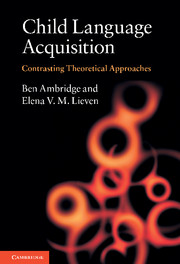Book contents
- Frontmatter
- Contents
- List of figures
- List of tables
- List of boxes
- List of summary tables
- Preface
- Acknowledgements
- 1 Introduction
- 2 Speech perception, segmentation and production
- 3 Learning word meanings
- 4 Theoretical approaches to grammar acquisition
- 5 Inflection
- 6 Simple syntax
- 7 Movement and complex syntax
- 8 Binding, quantification and control
- 9 Related debates and conclusions
- Notes
- References
- Author index
- Subject index
7 - Movement and complex syntax
Published online by Cambridge University Press: 05 June 2012
- Frontmatter
- Contents
- List of figures
- List of tables
- List of boxes
- List of summary tables
- Preface
- Acknowledgements
- 1 Introduction
- 2 Speech perception, segmentation and production
- 3 Learning word meanings
- 4 Theoretical approaches to grammar acquisition
- 5 Inflection
- 6 Simple syntax
- 7 Movement and complex syntax
- 8 Binding, quantification and control
- 9 Related debates and conclusions
- Notes
- References
- Author index
- Subject index
Summary
The previous chapter dealt with children's acquisition of sentences that use canonical (basic) declarative word order and that are ‘simple’, in the sense that they contain a single clause expressing a single proposition or idea (e.g. The boy kicked the ball). The present chapter investigates children's acquisition of sentences that use different word orders (passives and questions; e.g. The ball was kicked by the boy; What did the boy kick?; Section 7.1) and multiple-clause sentences (e.g. The boy who is smoking is crazy; Section 7.2).
The four debates covered here – on the acquisition of passives, questions, relative clauses and sentential complement clauses – are each a debate between generativist accounts on the one hand, and constructivist accounts on the other. On the generativist side, although we cover a number of different proposals, most modern approaches share an important similarity in assuming that children have the competence necessary to produce and comprehend these structures from birth. Thus generativist research has generally attempted to show that, when various task demands are minimized, children show adultlike performance with these structures from a very early age. Constructivist approaches assume that children are not born with the necessary syntactic knowledge, but must acquire these constructions on the basis of the input. Thus, as for the acquisition of basic word order (Chapter 6), constructivist research has generally attempted to show that early knowledge of these constructions is restricted to low-scope frames built around certain items, that gradually increase in abstraction with age.
- Type
- Chapter
- Information
- Child Language AcquisitionContrasting Theoretical Approaches, pp. 269 - 313Publisher: Cambridge University PressPrint publication year: 2011



